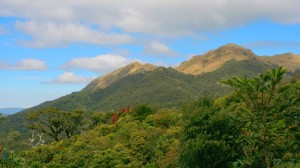Mountaineering in Mount Pulag is a growing activity in the Philippines. This is one travel destination in the Philippines you can try with your group.

Mount Pulag is one of the favorite climbs for many beginning climbers. Located in the tri-border area of the provinces of Benguet, Ifugao and Nueva Vizcaya in Northern Luzon, Mount Pulag is the second highest mountain in the country with its peak at 2,922 meters above sea level, only 72 meters short of the highest mountain in the islands, Mount Apo.
How to get there
To start your mountaineering in Mount Pulag, the easiest way would be to go to Baguio City. I wrote an article about Baguio so you may want to check it out, but for those who didn’t get to see that article I’ll give you a rundown.
From Manila, you can get a bus ride to Baguio from the Victory Liner bus company, located on EDSA. Most taxi drivers know where this terminal is so it shouldn’t be a problem finding it. The bus ride should cost about 500-600 pesos and should take about 6-7 hours so try to get a late trip, something around 10pm so that you get to Baguio City in the wee hours of the morning. Once in Baguio, you can rent a jeepney or ride the public buses to Ambaneg, near the foot of the mountains. A jeepney rental can cost around 7500 for a day, depending on the number of passengers and cargo.
How to get started
Once in Ambangeg, you can head to the Mountain Ranger Station. The roads to the station are pretty much rough and unpaved and usually headed uphill and narrow so it can get a bit hairy at times but with the experience of drivers and their specialized vehicles, the trip shouldn’t be a problem. During the peak seasons of February to May, travel can get a bit difficult as many travelers are looking to visit and go mountaineering in Mount Pulag.
You can stay for a while in the ranger station to prepare for your climb and get an experienced guide up the mountain. But during your stay at the station, you should know that the rangers expect a contribution which they use to maintain the station for other visitors.
The Ranger Station located about 2300 meters above sea level and is the jump off point for the climb. The climb to the peak is only about 9 kilometers over the Ranger Station trail. If you want to get a better experience of the trip, try hooking up with a Philippine mountaineering group, these groups often climb at a leisurely pace and would rather enjoy the sites and sounds of mountain rather than trying to race up the slopes to get to the top. And what a sight it is, the mountain has myriad of flora and fauna for you to see. Among the flora and fauna are 33 bird species, the rare Philippine deer, the fruit bats and the nearly 530 documented species of plants, trees, shrubs and bushes. Also, the mountain is the home to cloud rats and is home to rare breeds of other animals which can only be found in the Cordillera region.
You should also know that Mount Pulag is a national park because of its bio-diversity and so littering, hunting and cutting of trees are not allowed within the park. The park rangers enforce these rules strictly so be sure to take nothing but pictures, kill nothing but time and leave nothing but foot prints when you visit this natural wonder. Be sure to bring all the things necessary for a climb, check the mountaineering in Mount Pulag and other sites for further recommendations and good luck!
Best time to trek
The best time to visit Mount Pulag is between November and May, when the weather is stable and the storms aren’t blowing in as Northern Luzon is often visited by a number of typhoons a year.